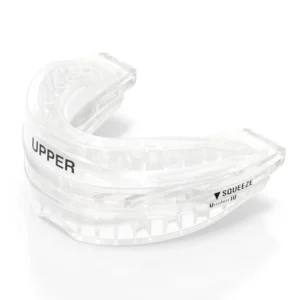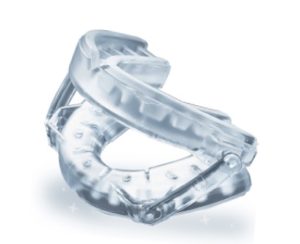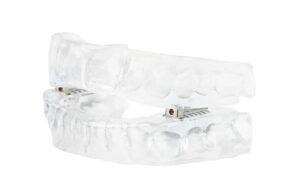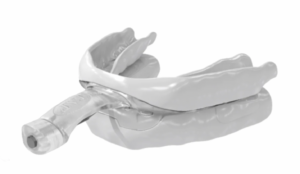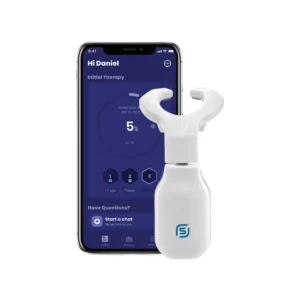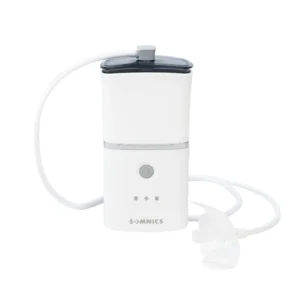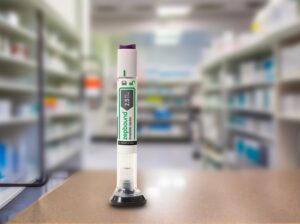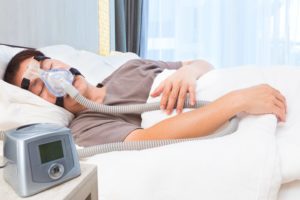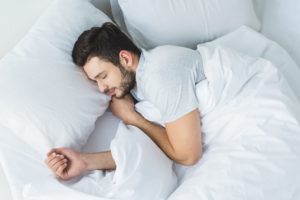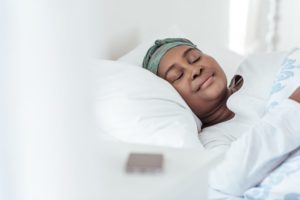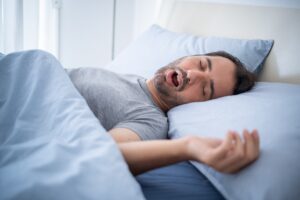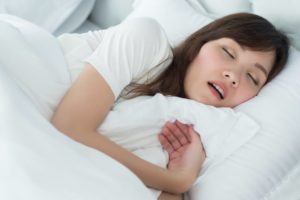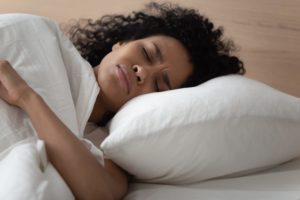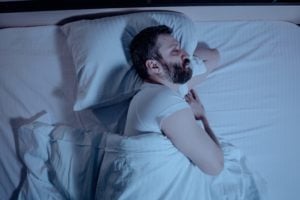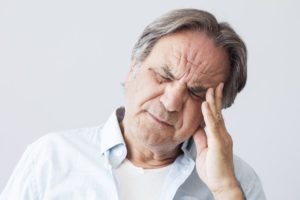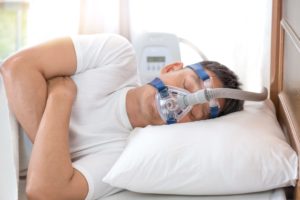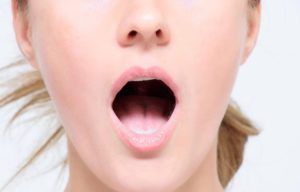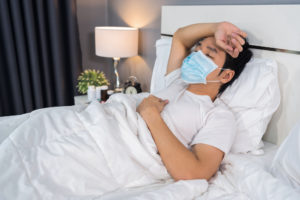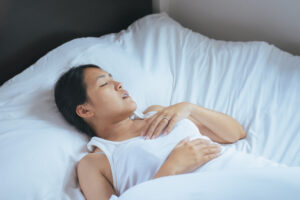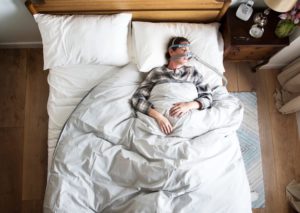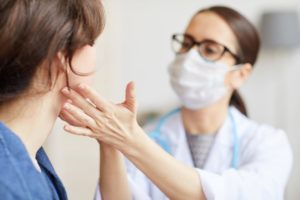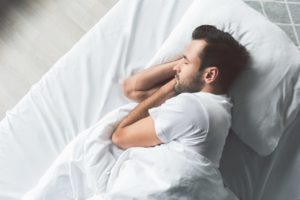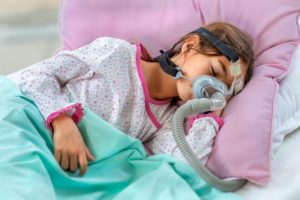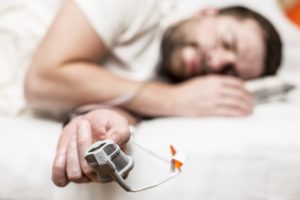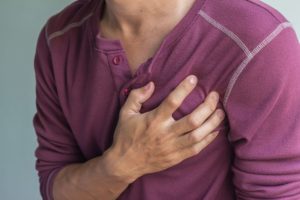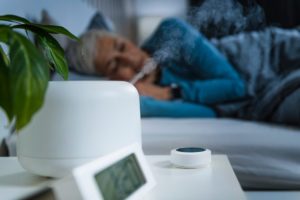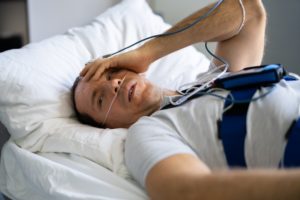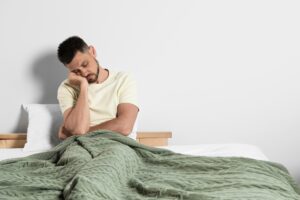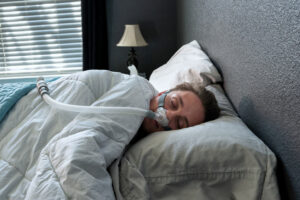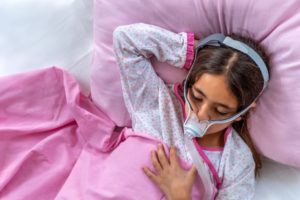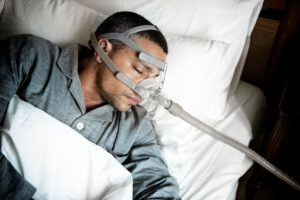When you buy through our links, we may earn a commission. Products or services may be offered by an affiliated entity. Learn more.
Sleep Apnea Mouth Guards
- How They Work: Sleep apnea mouth guards, also called oral appliances, reposition the jaw or tongue to keep the airway open during sleep.
- Types: The two primary kinds are mandibular advancement devices (MADs), which move the lower jaw forward, and tongue-retaining devices (TRDs), which hold the tongue in place to prevent obstruction.
- Benefits: These mouth guards can reduce snoring, improve breathing, and offer a quieter, travel-friendly alternative to CPAP for people with mild to moderate sleep apnea.
- Risks: Some users experience jaw discomfort, tooth movement, drooling, or dry mouth. Professional fitting and regular follow-ups help minimize these side effects.
For people who struggle to tolerate CPAP therapy, a sleep apnea mouth guard offers a simpler, quieter way to improve breathing and reduce snoring. Also known as oral appliances, these devices move the jaw or tongue forward so the airway can stay open during sleep.
Below, we’ll cover the different types of oral appliances used to treat sleep apnea, the benefits and potential risks, and what to consider when discussing this treatment option with your doctor.
How Mouth Guards Treat Sleep Apnea
An estimated 10% to 30% of adults have obstructive sleep apnea (OSA), although the condition often goes undiagnosed. In OSA, a person’s airway completely or partially collapses during sleep, causing gasping, choking, and snoring sounds, along with lowered blood oxygen levels and sleep disturbances.
Oral appliances for sleep apnea address underlying structural factors that contribute to obstructive sleep apnea, such as a small lower jaw or a tongue that falls back into the throat. Most commonly, sleep apnea mouth guards move the lower jaw forward, opening up the airway, although some adjust the tongue’s position forward instead.
While these oral appliances may be referred to as mouth guards, it’s important to note that they differ from over-the-counter mouth guards for teeth grinding or anti-snoring devices.
Types of Sleep Apnea Mouth Guards
Sleep apnea mouth guards come in a few designs that work in different ways to help keep the airway open during sleep. Each type targets a specific cause of airway obstruction—whether it’s the tongue falling back, the jaw relaxing, or the soft palate vibrating.
While all share the goal of improving airflow and reducing apneas, their comfort, effectiveness, and suitability can vary from person to person. Understanding how each device works can help you and your healthcare provider choose the right one for your needs.
Mandibular Advancement Devices (MADs)
Also known as a mandibular repositioning device (MRD) and mandibular advancement splint (MAS), a mandibular advancement device moves the lower jaw into a forward position. The word mandibular refers to the lower jawbone.
Some MADs have a one-piece design, while others have a two-piece design, with upper and lower guards that are connected. One-piece designs fix both the upper and lower jaw in place, which some people find restrictive .
Because two-piece designs have separate pieces for the upper and lower jaw, they allow for more movement and opening of the lower jaw, which some people may find more comfortable. However, oral appliances that allow more movement may not be ideal for people who sleep on their backs .
Tongue-Retaining Devices (TRDs)
Tongue-retaining devices, or TRDs, are oral appliances designed to keep the tongue in a forward position during sleep, preventing it from falling back and blocking the airway.
A TRD typically looks like a soft, flexible mouthpiece that sits between the lips and teeth. The front portion has a small bulb or chamber that uses gentle suction to hold the tip of the tongue in place while you sleep. It resembles a pacifier, but instead of being chewed or bitten, the user inserts their tongue into the device and creates suction to keep it forward.
Unlike MADs, which reposition the lower jaw, TRDs work without requiring jaw movement, making them a potential option for people who have temporomandibular joint (TMJ) disorders, limited jaw mobility, or missing teeth. However, some users find TRDs less comfortable or harder to adjust to, as the suction can cause mild tongue soreness, drooling, or difficulty maintaining a seal through the night.
Soft Palate Lifters
Soft palate lifters are a less common type of oral appliance designed to elevate the soft palate and uvula—the tissues at the back of the mouth that often vibrate and contribute to snoring. By gently supporting or repositioning these structures, soft palate lifters aim to reduce airway vibration and collapse, helping minimize snoring and mild airflow obstruction during sleep.
However, clinical research on soft palate lifters is very limited, and their effectiveness for treating obstructive sleep apnea has not been well established. Some early designs showed promise for reducing snoring, but results have been inconsistent, and many users report discomfort or difficulty keeping the device in place through the night. As a result, they’re not commonly prescribed for moderate or severe sleep apnea.
Custom-Fitted vs. Over-the-Counter Mouth Guards
Sleep apnea mouth guards are available in two main categories: custom-fitted devices prescribed by a dentist or sleep specialist, and over-the-counter (OTC) mouth guards that can be purchased online or in stores. While both are designed to help keep the airway open during sleep, they differ significantly in comfort, effectiveness, and long-term use.
Custom-fitted oral appliances are individually molded by a qualified dentist, often using digital scans or impressions of your teeth and jaw. This allows for a precise fit that supports your airway while minimizing discomfort or jaw strain.
OTC mouth guards, often called “boil-and-bite” devices, are heated and molded at home to fit your teeth. They’re primarily marketed for snoring reduction, though some users try them as a lower-cost alternative for mild OSA.
Benefits of Sleep Apnea Mouth Guards
Research has found that sleep apnea oral appliances can provide the following benefits for people with obstructive sleep apnea:
- Reduce the number of pauses in breathing (apneas) or episodes of shallow breathing (hypopneas)
- Significantly improve blood oxygen levels
- Decrease the frequency and volume of snoring
- Reduce daytime sleepiness
After a few years of treatment, sleep apnea mouth guard usage is associated with improvements in diastolic and systolic blood pressure, as well as continued improvement in quality of life and decreased daytime sleepiness.
Sleep apnea oral appliances can be a safe and effective alternative to CPAP therapy. As many as 46% to 83% of people don’t continue with CPAP therapy due to discomfort or another reason. If people find mouth guards more comfortable, they may be more likely to follow through with their treatment as directed.
Studies show that people who use an oral appliance to treat OSA may use it one more night per week, on average, than people who use CPAP, and nearly two hours longer per night. As a baseline, sleep experts recommend using either a mouth guard or CPAP machine for at least four hours per night for OSA therapy. Only 43% of people using CPAP meet this recommendation, compared with 76% of those using a mouth guard.
Potential Risks of Sleep Apnea Mouth Guards
While oral appliances are a good option for some, they’re not always as effective in treating OSA as CPAP. Nearly twice as many people completely treat OSA with CPAP than with a mouth guard. Research also suggests that CPAP therapy contributes to a further reduction in respiratory events during sleep and a larger improvement in blood oxygen levels. And for about one-third of people, mouth guards do not significantly improve their sleep apnea symptoms .
Although some people find oral appliances more comfortable than CPAP, not all do. One small survey found that more than half of the respondents had stopped using their mouth guard within a year due to discomfort. However, those who continued wearing the mouth guard reported better sleep quality, with less snoring and daytime sleepiness.
Sleep apnea mouth guards can also cause changes in teeth position or bite. In some cases these changes can actually be beneficial, such as reducing overbite or overjet, which is when the upper teeth bend forward at an angle over the bottom teeth. Often, these changes are barely noticeable, but they may appear within six months of starting treatment.
Are Sleep Apnea Mouth Guards Safe?
Generally, sleep apnea mouth guards are considered safe, but they can have side effects. It’s important to work closely with your health care provider when selecting and using a sleep apnea mouth guard.
Side effects are most common in the first two months and usually go away as a person gets used to the device. Side effects may include:
- Drooling
- Dry mouth
- Gum irritation
- Headaches
- Tooth pain
- Temporomandibular joint (TMJ) discomfort
For some people, TMJ pain may be more acute initially, though it typically decreases over time and resolves in most cases within six to 12 months.
How to Choose the Right Sleep Apnea Mouth Guard
Finding the right sleep apnea mouth guard depends on your diagnosis, comfort preferences, and treatment goals. Because not every device works the same way—or fits every mouth—understanding the key factors can help you make an informed decision and get the best results.
Before buying any mouth guard, it’s essential to confirm whether you have obstructive sleep apnea (OSA), central sleep apnea, or primary snoring. A sleep study is the only way to determine the type and severity of your condition. Mouth guards are most effective for mild to moderate OSA and may not be suitable for more severe cases that require CPAP or other medical treatments.
Consider the Type of Device
As explained above, the two main types of oral appliances are:
- Mandibular Advancement Devices (MADs): move the lower jaw forward to prevent airway collapse
- Tongue-Retaining Devices (TRDs): hold the tongue in a forward position to keep the airway clear.
Your provider can help determine which design best fits your mouth shape and breathing pattern.
Evaluate Fit and Comfort
Comfort is key for long-term use. Look for a device that feels secure but not restrictive, allows you to breathe through your nose easily, and doesn’t cause excessive drooling or soreness. Custom-fitted devices offer the best comfort and results, while over-the-counter versions may require trial and error.
Check Adjustability and Follow-Up Care
Many custom mouth guards allow for incremental jaw adjustments, helping fine-tune the position for maximum airway support. Regular follow-ups with your dentist or sleep specialist are important to assess fit, reduce side effects, and track treatment success.
When to Talk to Your Doctor
If you’re considering a mouth guard for sleep apnea, the first step is to speak with your healthcare team, which may include a primary care provider, sleep specialist, and dentist trained in oral appliance therapy. These professionals can help determine whether a mouth guard is appropriate for your type and severity of sleep apnea and guide you through the fitting process.
A sleep study—either in a lab or at home—is typically needed to confirm your diagnosis and measure how severe your sleep apnea is. Based on those results, your doctor can discuss whether a MAD, TRD, or another treatment option is best suited for you.
Once your device is fitted, follow-up care is essential. Schedule appointments with your dentist and sleep specialist every few months during the first year to ensure:
- The device still fits properly and remains comfortable.
- It’s effectively reducing apnea events and improving sleep quality.
- You are not developing side effects such as jaw pain, shifting teeth, or bite changes.
If your symptoms return, your partner notices loud snoring or breathing pauses, or your device becomes uncomfortable, contact your provider for an adjustment. Over time, your mouth guard may need to be refitted or replaced to maintain optimal results.
Frequently Asked Questions
How much do sleep apnea mouth guards cost?
Overall, a sleep apnea mouth guard may cost
less
than CPAP therapy. The specific price can depend on several factors. The total cost includes the cost of the device and cleaning solution, as well as the cost of the initial exam and follow-up dental appointments for fitting the device.
People interested in an oral appliance should check with their insurance provider to see if it is covered. In general, two-piece mouth guards are
more expensive
than one-piece designs.
Does insurance pay for mouthpieces for sleep apnea?
Many medical insurance plans, including Medicare, cover custom-fitted oral appliances prescribed for obstructive sleep apnea. Coverage typically applies when the device is ordered by a qualified sleep physician or dentist after a confirmed diagnosis from a sleep study.
However, benefits vary depending on your plan and provider. Before treatment begins, ask your dentist or sleep specialist to submit a preauthorization request and confirm which costs—such as fittings, follow-up visits, or replacement devices—are included. Over-the-counter mouth guards and snoring-only devices are usually not covered because they aren’t considered medical-grade treatments.
Who are sleep apnea mouth guards best for?
The American Academy of Sleep Medicine recommends sleep apnea mouth guards for:
– People with mild to moderate OSA
– People who snore but do not have OSA
– People with severe OSA who did not respond well to or do not want CPAP therapy
Some research suggests MADs may be
particularly effective
in people with lower body weights and narrower areas behind the tongue or soft palate, regardless of the severity of their OSA.
Who shouldn’t use an oral appliance for sleep apnea?
Oral appliances are best suited for people with mild to moderate obstructive sleep apnea or those who can’t tolerate CPAP therapy. They are not recommended for:
– People with severe OSA unless prescribed and closely monitored by a sleep specialist.
– Those with significant jaw problems (TMJ disorders), loose teeth, or extensive dental work that could make wearing a mouthpiece uncomfortable or unsafe.
– Individuals with central sleep apnea, since oral appliances do not address brain-related breathing issues.
Do I need a prescription for a sleep apnea mouth guard?
People with sleep apnea should work closely with their doctor, orthodontist, or dentist when considering a sleep apnea mouth guard. While some options are available without a prescription, custom-fitted oral appliances are more effective at treating sleep apnea.
How often should you clean your mouth guard?
Follow the device’s instructions for how to clean your sleep apnea mouth guard and how often. Some manufacturers, like SomnoMed, recommend daily cleaning along with your typical morning hygiene routine. Use the recommended cleaning solution and brush. Then, rinse, dry, and store according to the instructions. Soak and disinfect the mouth guard on a weekly basis using the recommended cleaning solution or tablet.

Still have questions? Ask our community!
Join our Sleep Care Community — a trusted hub of sleep health professionals, product specialists, and people just like you. Whether you need expert sleep advice for your insomnia or you’re searching for the perfect mattress, we’ve got you covered. Get personalized guidance from the experts who know sleep best.
References
12 Sources
-
Sutherland, K., Vanderveken, O. M., Tsuda, H., Marklund, M., Gagnadoux, F., Kushida, C. A., & Cistulli, P. A. (2014). Oral appliance treatment for obstructive sleep apnea: An update. Journal of Clinical Sleep Medicine, 10(2), 215–227.
https://pubmed.ncbi.nlm.nih.gov/24533007/ -
Kline, L. R. (2022, April 1). Clinical presentation and diagnosis of obstructive sleep apnea in adults. In N. Collop (Ed.). UpToDate.
https://www.uptodate.com/contents/clinical-presentation-and-diagnosis-of-obstructive-sleep-apnea-in-adults -
Slowik, J. M., & Collen, J. F. (2021). Obstructive sleep apnea. StatPearls.
https://pubmed.ncbi.nlm.nih.gov/29083619/ -
Ishiyama, H., Hasebe, D., Sato, K., Sakamoto, Y., Furuhashi, A., Komori, E., & Yuasa, H. (2019). The efficacy of device designs (mono-block or bi-block) in oral appliance therapy for obstructive sleep apnea patients: A systematic review and meta-analysis. International Journal of Environmental Research and Public Health, 16(17), 3182.
https://pubmed.ncbi.nlm.nih.gov/31480465/ -
Sutherland, K., & Cistulli, P. A. (2019). Oral appliance therapy for obstructive sleep apnoea: State of the art. Journal of Clinical Medicine, 8(12), 2121.
https://pubmed.ncbi.nlm.nih.gov/31810332/ -
Ramar, K., Dort, L. C., Katz, S. G., Lettieri, C. J., Harrod, C. G., Thomas, S. M., & Chervin, R. D. (2015). Clinical practice guideline for the treatment of obstructive sleep apnea and snoring with oral appliance therapy: An update for 2015. Journal of Clinical Sleep Medicine, 11(7), 773–827.
https://pubmed.ncbi.nlm.nih.gov/26094920/ -
Basyuni, S., Barabas, M., & Quinnell, T. (2018). An update on mandibular advancement devices for the treatment of obstructive sleep apnoea hypopnoea syndrome. Journal of Thoracic Disease, 10(Suppl 1), S48–S56.
https://pubmed.ncbi.nlm.nih.gov/29445528/ -
Dieltjens, M., & Vanderveken, O. (2019). Oral appliances in obstructive sleep apnea. Healthcare, 7(4), 141.
https://pubmed.ncbi.nlm.nih.gov/31717429/ -
Nishigawa, K., Hayama, R., & Matsuka, Y. (2017). Complications causing patients to discontinue using oral appliances for treatment of obstructive sleep apnea. Journal of Prosthodontic Research, 61(2), 133–138.
https://pubmed.ncbi.nlm.nih.gov/27561445/ -
Sadatsafavi, M., Marra, C. A., Ayas, N. T., Stradling, J., & Fleetham, J. (2009). Cost-effectiveness of oral appliances in the treatment of obstructive sleep apnoea-hypopnoea. Sleep & Breathing, 13(3), 241–252.
https://pubmed.ncbi.nlm.nih.gov/19229577/ -
Isacsson, G., Fodor, C., & Sturebrand, M. (2016). Obstructive sleep apnea treated with custom-made bibloc and monobloc oral appliances: A retrospective comparative study. Sleep & Breathing, 21(1), 93–100.
https://pubmed.ncbi.nlm.nih.gov/27380034/ -
Park, P., Jeon, H. W., Han, D. H., Won, T. B., Kim, D. Y., Rhee, C. S., & Kim, H. J. (2016). Therapeutic outcomes of mandibular advancement devices as an initial treatment modality for obstructive sleep apnea. Medicine, 95(46), Article e5265.
https://pubmed.ncbi.nlm.nih.gov/27861349/


